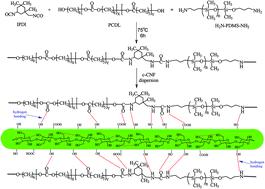当前位置:
X-MOL 学术
›
Polym. Chem.
›
论文详情
Our official English website, www.x-mol.net, welcomes your
feedback! (Note: you will need to create a separate account there.)
Effects of polysiloxanes with different molecular weights on in vitro cytotoxicity and properties of polyurethane/cotton–cellulose nanofiber nanocomposite films
Polymer Chemistry ( IF 4.1 ) Pub Date : 2020-07-09 , DOI: 10.1039/d0py00809e Chang-An Xu 1, 2, 3, 4, 5 , Bingfei Nan 1, 2, 3, 4, 5 , Mangeng Lu 1, 2, 3, 4, 5 , Zhencai Qu 1, 2, 3, 4, 5 , Zhiyou Tan 1, 2, 3, 4, 5 , Kun Wu 1, 2, 3, 4, 5 , Jun Shi 1, 2, 3, 4, 5
Polymer Chemistry ( IF 4.1 ) Pub Date : 2020-07-09 , DOI: 10.1039/d0py00809e Chang-An Xu 1, 2, 3, 4, 5 , Bingfei Nan 1, 2, 3, 4, 5 , Mangeng Lu 1, 2, 3, 4, 5 , Zhencai Qu 1, 2, 3, 4, 5 , Zhiyou Tan 1, 2, 3, 4, 5 , Kun Wu 1, 2, 3, 4, 5 , Jun Shi 1, 2, 3, 4, 5
Affiliation

|
A series of polyurethane/cotton–cellulose nanofiber nanocomposite films are manufactured using amino-terminated polydimethylsiloxane (H2N-PDMS-NH2), polycarbonate diol (PCDL), isophorone diisocyanate (IPDI), and dispersed cotton–cellulose nanofibers (c-CNF). The heat resistance, hydrophobicity, mechanical properties, surface morphology and effect on cells of the film are studied. The results show that as the molecular weight of H2N-PDMS-NH2 increases, the heat resistance and hydrophobicity of the material improve, and when the molecular weight is 4000, its surface free energy reaches 14.9 mJ m−2. This is mainly because an increase in the molecular weight of H2N-PDMS-NH2 changes the chemical structure of the polymer and increases the possibility of low surface energy Si enrichment on the surface. In addition, the cell viability reaches 78.31% in the MTT experiment, which may be related to the biocompatibility of H2N-PDMS-NH2. The relative hemolysis rate of the polymer material to red blood cells is less than 2%, and also shows lower adhesion to platelet cells, which may be related to the hydrophobicity of the surface.
中文翻译:

不同分子量的聚硅氧烷对聚氨酯/棉纤维素纳米纤维纳米复合薄膜体外细胞毒性和性能的影响
使用氨基封端的聚二甲基硅氧烷(H 2 N-PDMS-NH 2),聚碳酸酯二醇(PCDL),异佛尔酮二异氰酸酯(IPDI)和分散的棉-纤维素纳米纤维(c- CNF)。研究了耐热性,疏水性,机械性能,表面形态以及对薄膜细胞的影响。结果表明,随着H 2 N-PDMS-NH 2分子量的增加,材料的耐热性和疏水性提高,当分子量为4000时,其表面自由能达到14.9 mJ m -2。这主要是因为H 2 N-PDMS-NH 2的分子量增加改变了聚合物的化学结构,增加了表面能低的Si富集的可能性。另外,MTT实验中细胞活力达到78.31%,这可能与H 2 N-PDMS-NH 2的生物相容性有关。聚合物材料对红细胞的相对溶血率小于2%,并且还显示出与血小板细胞的较低粘附性,这可能与表面的疏水性有关。
更新日期:2020-08-18
中文翻译:

不同分子量的聚硅氧烷对聚氨酯/棉纤维素纳米纤维纳米复合薄膜体外细胞毒性和性能的影响
使用氨基封端的聚二甲基硅氧烷(H 2 N-PDMS-NH 2),聚碳酸酯二醇(PCDL),异佛尔酮二异氰酸酯(IPDI)和分散的棉-纤维素纳米纤维(c- CNF)。研究了耐热性,疏水性,机械性能,表面形态以及对薄膜细胞的影响。结果表明,随着H 2 N-PDMS-NH 2分子量的增加,材料的耐热性和疏水性提高,当分子量为4000时,其表面自由能达到14.9 mJ m -2。这主要是因为H 2 N-PDMS-NH 2的分子量增加改变了聚合物的化学结构,增加了表面能低的Si富集的可能性。另外,MTT实验中细胞活力达到78.31%,这可能与H 2 N-PDMS-NH 2的生物相容性有关。聚合物材料对红细胞的相对溶血率小于2%,并且还显示出与血小板细胞的较低粘附性,这可能与表面的疏水性有关。











































 京公网安备 11010802027423号
京公网安备 11010802027423号